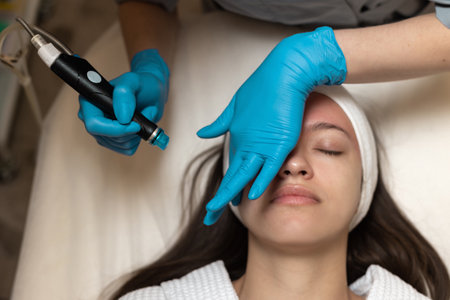1. Understanding Laser Hair Removal
Laser hair removal has quickly become one of the most popular ways to achieve long-term hair reduction in the United States. But how does it really work, and why do so many people choose it over traditional methods like shaving or waxing? Let’s break down the basics in a way that’s easy to understand.
How Does Laser Hair Removal Work?
Laser hair removal uses concentrated beams of light (lasers) to target and damage hair follicles beneath the skin. The pigment (color) in your hair absorbs the light, which turns into heat and destroys the hair follicle. This process slows down future hair growth and, after several sessions, can lead to permanent reduction in hair in the treated areas.
The Technology Behind It
| Type of Laser | Best For | Main Features |
|---|---|---|
| Alexandrite | Lighter skin tones | Fast treatment, effective on large areas like legs |
| Diode | Most skin types | Deep penetration, versatile for different body parts |
| Nd:YAG | Darker skin tones | Lower risk of skin damage, safe for more complexions |
| Ruby | Very fair skin | Less commonly used, gentle on sensitive areas |
Why Is It So Popular in the U.S.?
- Convenience: Unlike shaving or waxing, laser treatments can give you smooth skin for months or even years.
- Saves Time: Fewer trips to the salon mean more time for yourself.
- Cost-Effective Long-Term: While the upfront cost is higher, you’ll spend less money over time compared to constant waxing or buying razors.
- No More Ingrown Hairs: Many people find laser treatment helps reduce painful ingrown hairs, which are common with other methods.
- Cultural Preference: In American culture, smooth and hair-free skin is often considered desirable for both men and women, making this treatment highly sought after.
A Quick Comparison: Laser vs. Other Methods
| Treatment Type | Pain Level | Duration of Results | Main Drawback |
|---|---|---|---|
| Laser Hair Removal | Mild to moderate (with cooling gels) | Months to years (after multiple sessions) | Upfront cost; multiple sessions needed |
| Shaving | Low | A few days | Irritation, frequent upkeep needed |
| Waxing | Moderate to high (painful for some) | Weeks at best | Pain, risk of ingrown hairs and redness |
| Creams/Depilatories | Mild (may irritate sensitive skin) | A week or less | Chemical smell; possible allergic reactions |
2. Factors That Influence Session Numbers
When it comes to laser hair removal, there’s no one-size-fits-all answer for how many sessions you’ll need. Several key factors can impact your treatment plan. Let’s break down the main variables that play a role in determining the number of sessions required for smooth, hair-free skin.
Hair Color and Skin Type
The color of your hair and your skin tone are two of the biggest influences on laser hair removal results. Lasers target pigment (melanin) in the hair, so people with light skin and dark hair usually see the best results fastest. If your hair is blonde, red, gray, or very fine, or if you have a darker skin tone, you may need more sessions because the laser has a harder time differentiating between hair and skin.
| Hair Color | Skin Type | Estimated Sessions Needed |
|---|---|---|
| Dark | Light | 6-8 |
| Dark | Medium/Dark | 8-10 |
| Light (Blonde/Red/Gray) | Any | 10+ |
Treatment Area
Certain body parts respond differently to laser treatment. Areas with coarse, thick hair (like underarms or bikini line) generally require fewer sessions compared to areas with finer hair (like arms or face). Additionally, larger areas like legs or back might take longer simply due to the surface area being treated.
| Treatment Area | Typical Sessions Needed |
|---|---|
| Underarms | 6-8 |
| Bikini Line | 6-8 |
| Legs | 8-10 |
| Face (Upper Lip/Chin) | 8-12 |
| Back/Chest | 8-12 |
Your Genetics and Hair Growth Cycles
Your genes determine not only your hair color and thickness but also how quickly your hair grows back after each session. Some people naturally have stubborn hair that regrows faster or is more resistant to treatment, which means they might need extra sessions. Laser treatments work best during the growth phase of your hair cycle, so timing and genetics both matter here.
Other Influences to Consider:
- Hormonal Changes: Pregnancy, menopause, or certain medical conditions can affect hair growth.
- Aging: As we age, our hair texture and growth patterns can shift, influencing results.
- Lifestyle: Some medications or sun exposure habits can impact how effective each session is.
The Bottom Line on Session Numbers:
No two people will have exactly the same experience with laser hair removal. By understanding how these factors interact—hair color, skin type, treatment area size, genetics, hormones—you’ll have a better idea of what to expect on your journey to smoother skin.

3. What to Expect During Each Session
Before Your Appointment
Getting ready for a laser hair removal session is pretty straightforward, but there are a few things you should know ahead of time. Most clinics will ask you to:
- Shave the area: You’ll usually need to shave the treatment area about 24 hours before your appointment. This helps the laser focus on the hair follicle, not the hair above the skin.
- Avoid sun exposure: Try to keep out of the sun and skip tanning beds for at least two weeks before your session. Sunburned or tanned skin can be more sensitive and increase the risk of side effects.
- Skip waxing or plucking: Don’t wax or pluck hairs for at least four weeks before treatment because the laser needs the hair root present to be effective.
- Don’t apply lotions or deodorants: On the day of your appointment, make sure your skin is clean and free from lotions, creams, or deodorant in the treatment area.
Quick Prep Checklist
| Task | When to Do It |
|---|---|
| Shave Treatment Area | 24 Hours Before |
| Avoid Sun Exposure | 2 Weeks Before |
| No Waxing/Plucking | 4 Weeks Before |
| No Lotions/Deodorant | The Day Of |
During Your Appointment
Your provider will first check in with you, answer any last-minute questions, and review your health history if it’s your first visit. Here’s what typically happens next:
- Cleansing: The treatment area is cleaned thoroughly.
- Numbing (if needed): Some areas may get a numbing cream, especially if it’s your first session or if you’re treating sensitive spots.
- Eye Protection: Both you and your technician will wear protective eyewear for safety.
- The Laser Process: The technician uses a handheld device that delivers quick pulses of light to target hair follicles. Each pulse feels like a rubber band snap—uncomfortable for some, but usually tolerable.
- Duration: Small areas like the upper lip take just a few minutes; larger areas like legs may take up to an hour.
Sensation Scale: What Does It Feel Like?
| Treatment Area | Sensation Level (1-5) |
|---|---|
| Upper Lip/Chin | 3 (Mild Snap) |
| Bikini Line | 4 (Moderate Snap) |
| Legs/Arms | 2 (Light Tingle) |
After Your Appointment
You might notice some redness or mild swelling right after your session—this is totally normal and usually fades within a few hours. Here’s what else to expect and how to care for your skin:
- Avoid hot showers and saunas: For at least 24 hours after treatment, stick with cool water when bathing and avoid steamy environments.
- No harsh products: Skip exfoliating scrubs, retinol creams, or anything irritating until your skin calms down.
- Avoid sun exposure: Keep the area covered or use broad-spectrum sunscreen every day while going through treatments.
Post-Treatment Care Table
| Action | How Long? |
|---|---|
| Avoid Hot Showers/Saunas | 24 Hours After Session |
| No Exfoliants/Retinol Creams | 48-72 Hours After Session |
| Sunscreen Application | Daily Throughout Treatment Series |
Your provider will let you know when it’s time to book your next session—most people return every 4-6 weeks, depending on the area being treated. Each session gets you closer to smoother, hair-free skin!
4. Standard Recommendations for Session Counts
When it comes to laser hair removal, most people want to know how many sessions they’ll need before seeing smooth, lasting results. While the exact number can vary based on your skin type, hair color, and the specific area you’re treating, there are some general guidelines that apply to both men and women in the U.S. Here’s what you can expect:
Average Number of Sessions by Body Area
Laser hair removal works best when hair is in its active growth phase. Because not all hairs grow at the same time, multiple sessions are necessary to catch every follicle at the right stage. On average, most people need between 6 to 8 sessions for optimal results. The table below shows typical session counts for popular body areas for both men and women:
| Body Area | Women (Avg. Sessions) | Men (Avg. Sessions) |
|---|---|---|
| Upper Lip | 6-8 | 6-10 |
| Chin | 6-8 | 6-10 |
| Underarms | 6-8 | 7-10 |
| Bikini Line | 6-8 | N/A* |
| Legs (Full) | 8-10 | 8-12 |
| Back | N/A* | 8-12 |
| Chest | N/A* | 8-12 |
| Arms (Full) | 6-9 | 7-10 |
| Face (Full) | 6-8 | 7-10 |
*N/A: Not a common treatment area for this gender.
Main Factors Affecting Session Numbers
- Hair Thickness & Color: Coarse or dark hair typically responds faster than fine or light-colored hair.
- Skin Tone: Lighter skin with darker hair sees quicker results, but newer lasers work well across a range of skin tones.
- Treatment Area Size: Larger areas like legs or back may take more sessions compared to smaller spots like the upper lip.
If you’re considering laser hair removal, talk to your provider about a personalized plan—everyone’s starting point is different, but these averages offer a good place to begin!
5. Tips for Best Results and Maintaining Smooth Skin
Home Care Advice After Laser Hair Removal
Taking care of your skin at home is key to getting the best results from your laser hair removal sessions. Here are some simple tips to follow:
- Avoid Sun Exposure: Stay out of direct sunlight and always use sunscreen with at least SPF 30.
- Skip Hot Showers: Stick to lukewarm water for 24-48 hours after treatment to avoid irritating your skin.
- No Picking or Scratching: Let any treated hairs shed naturally—don’t pluck, wax, or scratch the area.
- Moisturize Gently: Use a fragrance-free moisturizer to keep your skin hydrated and calm.
- Stay Away from Harsh Products: Avoid retinoids, glycolic acids, and exfoliants for a few days post-treatment.
Timing Between Laser Sessions
The number of laser sessions you need depends on your hair type and the area being treated, but spacing them properly is just as important. Here’s a general guideline:
| Body Area | Recommended Interval |
|---|---|
| Face (upper lip, chin) | Every 4-6 weeks |
| Underarms & Bikini Line | Every 6-8 weeks |
| Legs & Arms | Every 8-10 weeks |
| Back & Chest | Every 8-12 weeks |
Your provider might adjust these intervals based on how your hair responds to treatment. Sticking to this schedule helps target hair in different growth phases for smoother results.
Pro Tips for Long-Lasting, Hair-Free Skin
- Don’t Miss Appointments: Consistency is key—try not to skip or delay scheduled sessions.
- Avoid Waxing or Plucking Between Sessions: Shaving is okay, but waxing and plucking can disrupt the hair growth cycle that laser targets.
- Treat Regrowth Promptly: If you notice new hair coming in after your initial round of treatments, book a touch-up session sooner rather than later.
- Talk to Your Provider: Share any changes in medication or health as these can affect your results and safety.
- Be Patient: Full results take time—a little patience goes a long way toward smooth, lasting skin!
Your Smooth Skin Routine At-A-Glance
| What To Do | How Often | Why It Matters |
|---|---|---|
| Sunscreen daily | Every day, especially post-treatment | Keeps skin protected from UV damage and discoloration |
| Avoid hot showers/saunas | First 48 hours after session | Reduces irritation and redness |
| No waxing/plucking | Between all sessions | Keeps hair follicles intact for best results |
| Soothe & moisturize | As needed after each session | Cuts down on dryness and calms skin |
If you stick to these easy steps at home and keep up with your appointments, you’ll get the most out of every laser hair removal session—and enjoy smoother, hair-free skin for longer.


